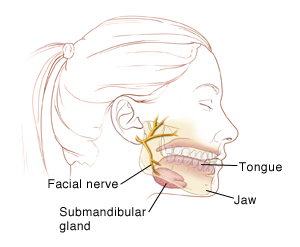Submandibular Gland Excision
Submandibular Gland Excision
The submandibular glands are 2 of the glands that make saliva. They lie just below each side of the jaw. Saliva flows from the glands to the mouth through a small duct. This duct can become blocked. This may be due to small deposits (called stones) in the gland. Or, it may be from narrowing of the duct. More rarely, a tumor forms in a gland. Such a tumor may be cancerous. If the flow of saliva is blocked by a stone or tumor, it can cause pain and swelling. A blocked gland is also at high risk for becoming infected. Submandibular gland excision surgery removes the whole gland. If cancer is present, removing the gland may be all or part of treatment. The other salivary glands will continue to produce saliva.

Preparing for surgery
Prepare for the surgery as you have been instructed. Be sure to tell your healthcare provider about all medicines you take. This includes over-the-counter drugs. It also includes herbs and other supplements. You may need to stop taking certain ones before surgery as directed by your healthcare provider. Also, follow any directions you’re given for not eating or drinking before surgery.
The day of surgery
The surgery takes 45 minutes or longer.
Before the surgery
Here is what to expect before the surgery begins:
-
An intravenous (IV) line is put into a vein in your arm or hand. This line delivers fluids and medicines.
-
You will be given medicine (anesthesia) to keep you free of pain during the surgery. This will be general anesthesia, which puts you into a state like deep sleep during the surgery.
During the surgery
Here is what to expect during the surgery:
-
A cut is made in the upper part of the neck, just below the jaw line, under the chin, behind the ear, or in the mouth.
-
Nearby muscles, nerves, and blood vessels are moved out of the way to expose the gland.
-
Great care is taken to protect the branch of the facial nerve that lies near the submandibular gland. A facial nerve monitor may be used to map the exact location of this nerve. This is a machine with a small sensor that is put onto your cheek.
-
The gland is removed.
-
If a cancerous tumor is present, a margin of tissue around the gland is also removed. Nearby lymph nodes may be removed as well.
-
When the procedure is complete, the cut is closed with sutures, surgical glue, or surgical strips.
-
A tube (drain) may be placed into the surgical area. This drains fluid that may build up after surgery. The drain may be removed before you leave the hospital. If not, you will be shown how to care for it at home.
-
You may have an injection of local anesthesia. This helps prevent pain after surgery.
Recovering in the hospital
After the surgery, you will be taken to a room to wake up from the anesthesia. At first, your throat will feel very sore. It may be hard to talk and swallow. You may also feel sleepy and nauseated from the anesthesia. You will receive medicine that controls pain. You may need to stay in the hospital for 1 to 2 night(s). Once you are ready to leave the hospital, you will be released to an adult family member or friend.
Recovering at home
Have someone stay with you for the next couple of days to help care for you as your healing begins. Once at home, follow the instructions you have been given. During your recovery:
-
Take any prescribed medicines as instructed.
-
Care for your cut as instructed. Check it daily for symptoms of infection, like increased redness, pain, swelling, drainage, or warmth.
-
Swallowing may be difficult for a few days. Eat and drink what feels most comfortable. If it hurts to chew, stick to soft foods. Try ice cream, gelatin, eggs, pasta, and mashed potatoes. Avoid hot, spicy, acidic, hard, or crunchy foods.
-
Get up and walk each day. This helps improve blood flow and breathing and promotes healing. But avoid exercise and strenuous activities for 7 days after surgery.
When to call your healthcare provider
Call your healthcare provider right away if you have any of these:
-
Chest pain or trouble breathing (call 911)
-
Fever of 100.4°F (38°C) or higher, or as directed by your healthcare provider
-
Symptoms of infection at an incision site, like increased redness or swelling, warmth, worsening pain, or foul-smelling drainage
-
Swallowing problems that get worse
-
Increasing throat pain or pain that is not relieved by medicine
-
Tongue numbness or inability to move tongue
-
Weakness of the mouth or lower lip
Follow-up
Follow up with your healthcare provider, or as advised to check on your healing. If cancer was removed, you may need more treatment. If this is the case, you and your healthcare provider will discuss your options.
Risks and possible complications
Risks of this procedure include:
-
Bleeding
-
Infection
-
Hematoma (a collection of blood under the skin)
-
Scarring
-
Problems speaking or swallowing (can be temporary or permanent)
-
Tongue numbness (can be temporary or permanent)
-
Damage to the facial nerve, leading to permanent weakness of the mouth and lip on that side
-
Risks of anesthesia. You will discuss these with the anesthesiologist.
Updated:
March 15, 2019
Sources:
Beahm, D., Surgical approaches to the submandicular gland: A review of literature, International Journal of Surgery (2009); 7; 503-509
Reviewed By:
Ashutosh Kacker MD